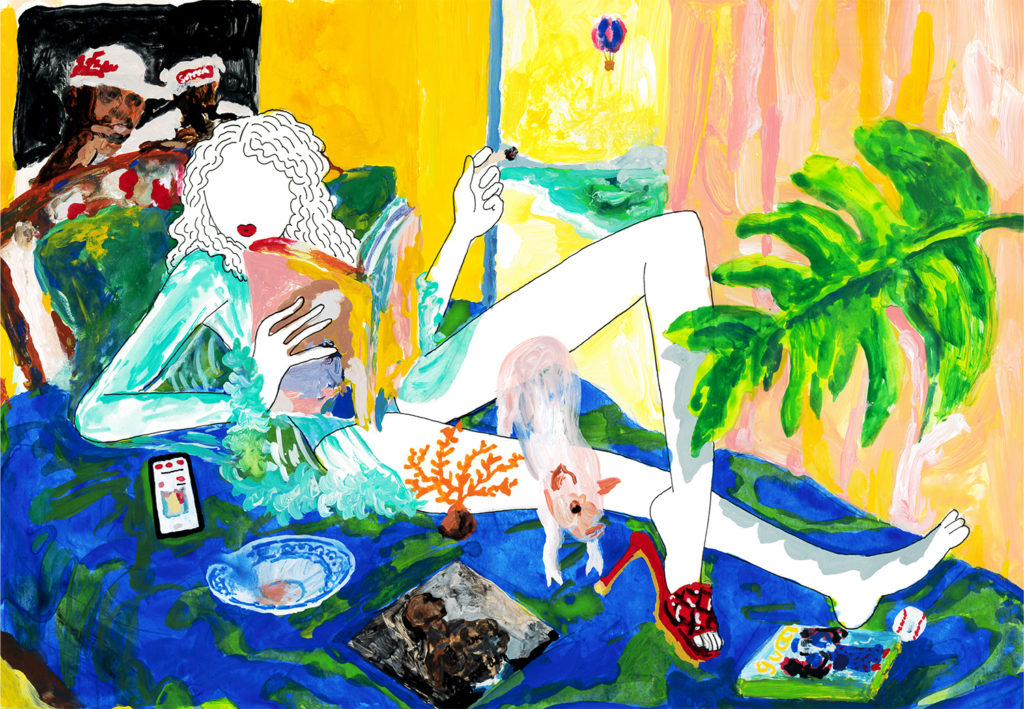When we look at the relationship between music and fashion, as well as between fashion trends and youth culture, we get a clearer understanding of the times we live in. In this series, Tsuya-chan, an up-and-coming writer, analyzes current cultural events by examining contemporary music with a focus on Japanese hip-hop.
Like the previous installment, where she focused on sneakers, she analyzes one clothing item instead of a fashion house in the fifteenth installment. The clothing item in question is jeans, a longstanding symbol of hip hop fashion. What have rappers depicted through putting their trust in jeans? Tsuya-chan gets down to the close relationship between hip hop and jeans by referencing the lyrics of BUDDHA BRAND, RHYMESTER, GADORO, and more.
The fate of a few centimeters of the jean waistline
The waistline is starting to look different in 2021. Just as ACROSS reported this fall, crop tops are trending, and it suddenly seems like people have started healthily showing skin more. Additionally, a couple of fashion houses have lowered the waistline during the SS 2022 season, and Vogue put out an article about it: How Low Can These Low-Rise Jeans Go? Effortless style a la Phoebe Philo, who was the creative director of Celine at the time, became in-style post-2009. Now, the style has reached the ultimate mode of relaxation, with people showing skin in a liberating and innocent manner.
The topic of the waistline is no laughing matter, however. The tension that exists in how many centimeters the jean waistline could move is notable in youth culture. We’ve found ourselves in many situations like listening to a breakbeat song where the 0.1-second delay is the determining factor of the song’s groove. Just as songs with pulsating kick-induced beats with the singing in between said beats transformed many people’s lives, the waistline of jeans governs people’s consciousness worldwide. For such a small detail, it sways fate in a big way.
Among youth culture, the tension regarding where the jeans hang on the waist is the rifest in hip hop and skater circles. There are various ideas on the origin of sagging pants; some say those who grew up in a poor household would buy oversized clothes, and incarcerated people would drag their low-hanging pants because they couldn’t get a belt. In Japan, many rappers have consciously worn their pants low (called koshipan) to express how loose-fitting they were and that they had momentum going even with a low center of gravity. For instance, Tohji’s extreme sagging pants tie in with the theme of his song, “Propella” well. His low, growling sounds are delightfully shocking. “Street Survivors –Blood, Sweat, Tears & Hip Hop-” by Infumiaikumiai was released last year and deemed a classic. In the lyrics, “Teens that dreamed of the city/ In baggy jeans/ A one-way ticket/ Hold onto one hand, for now,/ Beef with Dober ended in peace/ Both of us chasing after a street dream,” “baggy jeans” rhymes beautifully with “teens.”
The close relationship between jeans and hip hop; Gaki Ranger’s enthusiasm and BUDDHA BRAND’s maturity
Because jeans are integral in hip hop, rappers have put many meanings to that word in their lyrics. Gaki Ranger’s songs especially show love for jeans. In “NO PLAN B,” they rap, “Can’t stop movin’/ A maturity like secondhand blue jeans/ Bring about/ Artwork that impresses connoisseurs.” In “Rap Ojisan feat. AMIDA, KREVA,” they rap, “Quite lavish EVISBEATS/ Solid rap like denim jeans.” Gaki Ranger rhymes “movin’” with “blue jeans,” and it’s shown as a symbol of maturity. On the other hand, they rhyme “EVISBEATS,” the producer behind the song, with “denim jeans,” and describe jeans as solid rap. In hip hop, jeans have a pleasurable ring while they also get better with time. It conjures up the image that jeans are “solid.”
Allow me to recall BUDDHA BRAND’s lyrics. In 2003’s “RETURN OF THE BUDDHA BROS.,” the lines, “This is our universal style/ Ten years strong on this path/ Just like denim,” subtly allude to the maturity and solidness of jeans. Further, there’s one thing that happened in 2016 that we mustn’t forget. Jeans were referenced in a surprising fashion and became a historical moment in Japanese rap.
In “Boukyaku,” a poignant song in which KOHH raps in a swaying, airy spoken word-like way on top of a tense rhythm, Hikaru Utada responds to his verses: “Hot lips/ Cold hands/ Make me forget words/ Stiff jeans/ Kind eyes/ Call me by a nostalgic name.” The maturity and solidness of jeans connect to stiffness here.
Dragging stiff jeans and wandering the streets: a scenery depicted by RHYMESTER, a fate portrayed by GADORO
In Japanese rap, stiffness doesn’t only refer to the texture of jeans. There’s another reason behind the conflict surrounding where the jeans should sit at the waist, and started sagging as though they were going to drop. This key fate lies in the small details, so I’d like to look back on some lyrics again. In “Shibuya Hyouryuki,” RHYMESTER raps the following:
“Night cruising from club to club/ Fluttering oversized blue jeans/ Gripping my mic, hit ‘em with my routine/ Wild music this city nurtured”
Their stiff, oversized jeans drift the streets of Shibuya. Let’s listen even closer; “blue jeans” rhymes with “night cruising,” “routine,” and “music.” “Routine” relates to searching for dance moves and music while being on a night cruise. This makes one picture someone wandering the midnight streets as their jeans fall lower until the hem touches the ground. It’s just like what Creepy Nuts rapped on “Daga Sore de Ii”: “I’m starting to wear New Era/ Dragging my baggy jeans/ Heading out to Amemura/ They made me buy a hoodie.” GADORO’s “Life Is Go On” can’t be forgotten either:
“It’s too late to give lip service/ If the sound stops, it’s the same as dying/ I don’t talk, I pass it down/ Dragging jeans that are the past/ It’s the same as throwing the present away/ Right when I was born, I was already a loser”
Here, GADORO puts forward one answer. When he says, “Dragging jeans that is the past,” he means that the stiffness of his jeans, the way they sag, and the conflict of a few centimeters are all being dragged by the past. The past points to his origins. With fate he must accept, such as his origin, gender, and race, which were all passed down to him, he drags his stiff jeans and roams the streets.
Where the jeans sit on their waist is up to the individual as long as they can accept their origins and the stiffness of their jeans upon roaming the streets. Hip hop is open to women too. Women can wear distressed, low-rise jeans. Hip hop welcomes those who listen to hardcore or emo music. It’s okay to wear black jeans at the hip. In “GREEN QUEEN x PARKGOLF,” AKKOGORILLA says, “Distressed denim again/ With a rusty crown on my head/ A microphone on my left hand, let’s dance.” In “XXX,” kiLLa says, “A shiny gold chain/ My jeans are black.” Hip hop is extending a hand to you because you’ve accepted the hardness of denim and wander the streets. The only thing left to do is to loiter the streets, drag your pants, and rap. And dance. And make breakbeat music. Your jeans are bound to go lower. Where will your jeans fall on your hips? Hip hop dwells in those determining centimeters.
Illustration AUTO MOAI
Translation Lena Grace Suda


